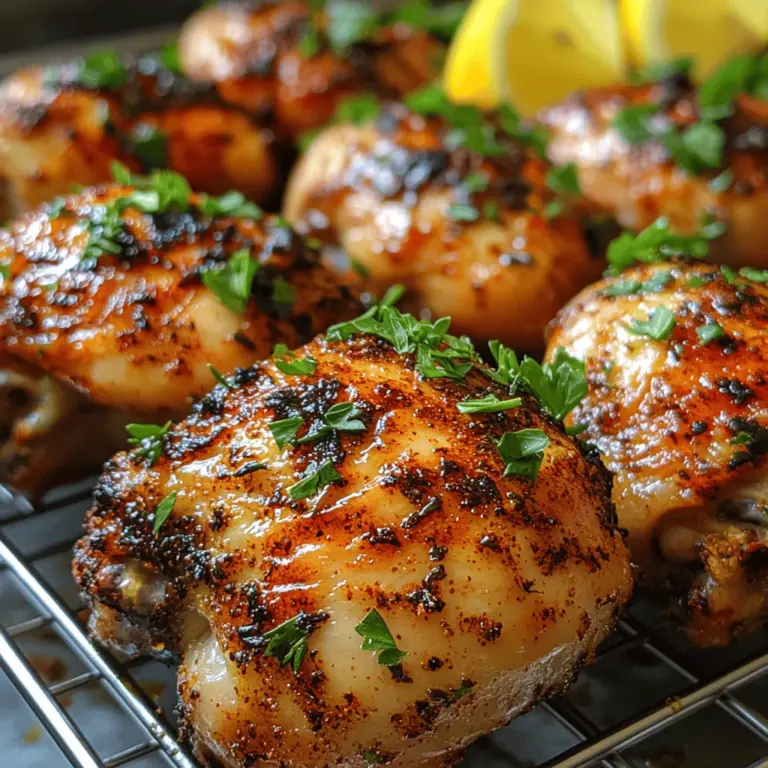Introduction
Crispy oven-baked chicken legs are a culinary delight that promises both flavor and texture in every bite. Whether you’re preparing a casual weeknight dinner or hosting an elegant gathering, the allure of perfectly seasoned, golden-brown chicken legs is undeniable. The crispy skin, combined with tender, juicy meat, offers an irresistible combination that appeals to both kids and adults alike. One of the best parts of this recipe is its simplicity, allowing home cooks of all skill levels to create a dish that feels gourmet yet requires minimal effort.
The secret to elevating these chicken legs lies in the thoughtful use of herbs and spices. These ingredients play a crucial role in enhancing the natural flavors of the chicken, transforming an ordinary meal into an extraordinary culinary experience. By infusing the chicken with a medley of fragrant herbs and robust spices, you’ll not only satisfy your taste buds but also create a dish that captivates the senses.
Moreover, opting for the oven-baking method over frying is a wise choice for health-conscious individuals. Baking chicken legs allows excess fat to drip away while retaining moisture within the meat, resulting in a dish that is both delicious and healthier. This method reduces the use of oils and fats that are typically found in frying, making it a great option for those who are looking to maintain a balanced diet without sacrificing flavor.
In this article, we will delve into the specifics of crafting your very own crispy herb-infused oven-baked chicken legs. From understanding the essential ingredients to exploring preparation steps that guarantee success in the kitchen, we’ll equip you with everything you need to create this delightful dish.
Understanding the Ingredients for Crispy Herb-Infused Chicken Legs
To achieve the perfect crispy herb-infused chicken legs, it’s essential to understand the role of each ingredient. This section will break down the key components that contribute to flavor, texture, and health benefits.
Overview of Chicken Legs: Drumsticks vs. Thighs
When it comes to chicken legs, you typically have two main cuts to choose from: drumsticks and thighs. Drumsticks are the lower part of the chicken leg, characterized by their tender meat and easy-to-hold shape, which makes them a favorite for casual dining and finger foods. On the other hand, thighs are the upper part of the leg, known for their rich flavor and slightly more fat, resulting in incredibly moist meat.
Both cuts are excellent for oven baking, but drumsticks are particularly popular due to their crispy skin and ease of cooking. Regardless of your choice, both options can be seasoned and baked to perfection, providing a succulent meal that will impress your guests or family.
Importance of Olive Oil for Flavor and Crispiness
Olive oil is a staple ingredient in any kitchen, and for good reason. When it comes to baking chicken legs, olive oil serves multiple purposes. First, it acts as a moisture-retaining agent, which helps keep the chicken juicy during the cooking process. Second, olive oil plays a significant role in achieving that coveted crispy skin. It coats the chicken evenly, promoting browning and crisping as it bakes.
Using high-quality extra virgin olive oil not only enhances the flavor but also contributes health benefits due to its rich content of monounsaturated fats and antioxidants. This makes it an excellent choice for those looking to maintain a healthier cooking style without compromising taste.
Role of Garlic Powder and Onion Powder in Seasoning
Garlic powder and onion powder are two essential seasonings that infuse the chicken legs with a depth of flavor that is hard to resist. Garlic powder adds a savory, aromatic quality that enhances the overall taste profile of the dish, while onion powder contributes a subtle sweetness and complexity.
Both ingredients are convenient, shelf-stable options that provide a consistent flavor without the fuss of chopping fresh garlic and onions. Their combination creates a savory foundation that complements the other spices and herbs, ensuring that every bite is packed with flavor.
Significance of Smoked Paprika in Achieving a Unique Flavor Profile
One of the standout ingredients in this recipe is smoked paprika. This spice is made from dried and smoked red peppers, giving it a distinctive smoky flavor that sets it apart from regular paprika. The addition of smoked paprika not only enriches the dish with a hint of smokiness but also adds a vibrant red color that makes the chicken legs visually appealing.
Incorporating smoked paprika into your seasoning mix elevates the overall flavor profile, adding an exciting twist that can transport your taste buds to a cozy, smoky barbecue setting. For those who enjoy a deeper flavor, smoked paprika is an essential ingredient that should not be overlooked.
Health Benefits of Dried Herbs: Thyme and Rosemary
Thyme and rosemary are two classic dried herbs that lend their aromatic qualities to the chicken legs. Both herbs are rich in antioxidants and have been associated with various health benefits, including anti-inflammatory properties and improved digestion.
Thyme offers a slightly earthy flavor with hints of mint and lemon, while rosemary provides a robust, pine-like aroma that pairs beautifully with chicken. These herbs not only enhance the taste of the dish but also contribute to its healthfulness, making them an excellent addition to your culinary repertoire.
The Impact of Salt and Black Pepper on Taste
Salt and black pepper are fundamental seasonings that are often taken for granted, yet they play a crucial role in enhancing the overall flavor of your chicken legs. Salt helps to draw out moisture from the chicken, allowing the flavors of the herbs and spices to penetrate the meat. It also enhances the natural flavors of the chicken, ensuring a well-rounded taste.
Black pepper, on the other hand, adds a subtle heat and complexity that elevates the entire dish. Its pungent flavor can balance out the richness of the chicken, creating a harmonious flavor profile that is satisfying to the palate. Together, salt and black pepper are essential components that should not be skipped in your seasoning mix.
Exploring Cayenne Pepper for Those Who Enjoy a Spicy Kick
For those who appreciate a little heat in their dishes, cayenne pepper is a fantastic addition to the seasoning blend for crispy herb-infused chicken legs. This fiery spice is derived from dried chili peppers and can add a spicy kick that contrasts beautifully with the other flavors in the dish.
Using cayenne pepper allows you to customize the level of spiciness to your preference. Start with a small amount and adjust as needed to find the right balance that suits your taste buds. The heat from the cayenne will not only enhance the complexity of flavors but also stimulate your appetite, making this dish even more enjoyable.
Preparation Steps for Perfectly Baked Chicken Legs
Now that we’ve explored the ingredients that make up our crispy herb-infused chicken legs, it’s time to dive into the preparation steps that will lead you to success in the kitchen. Following these steps will ensure that your chicken legs are perfectly baked, crispy, and bursting with flavor.
Preheating the Oven: Importance of Temperature in Cooking
The first step in preparing your crispy herb-infused chicken legs is to preheat your oven. Preheating is a crucial part of the cooking process, as it ensures that the chicken cooks evenly and thoroughly from the moment it enters the oven. For this recipe, a temperature of 425°F (220°C) is recommended, as it allows the chicken to crisp up beautifully while the meat remains tender and juicy.
While the oven is preheating, take a moment to prepare your marinade and seasonings. This multitasking will save you time and ensure that your chicken legs are ready to go as soon as the oven reaches the desired temperature.
Preparing the Marinade: Combining Flavors for Maximum Infusion
To create a flavorful marinade for your chicken legs, start by combining olive oil, garlic powder, onion powder, smoked paprika, dried thyme, dried rosemary, salt, black pepper, and cayenne pepper in a mixing bowl. Whisk the ingredients together until they form a cohesive blend. The olive oil will serve as the base, while the herbs and spices will provide a rich array of flavors.
Once the marinade is well mixed, add the chicken legs to the bowl, ensuring that each piece is generously coated with the seasoning blend. For maximum flavor infusion, allow the chicken to marinate for at least 30 minutes, or even longer if you have time. This step helps the flavors penetrate the meat, resulting in a more delicious final product.
The Science Behind Drying Chicken: Achieving Crispy Skin
Before baking your chicken legs, it’s essential to dry them thoroughly. This might seem like a minor detail, but it’s one of the keys to achieving crispy skin. Excess moisture on the surface of the chicken can lead to steaming rather than baking, preventing that desirable crispiness.
To dry the chicken legs, pat them with paper towels until they are completely free of moisture. This simple step will help create the perfect environment for browning and crisping as they bake in the oven.
Proper Coating Techniques: Ensuring Even Coverage of Marinade
Once your chicken legs are dried and marinated, it’s time to ensure they are properly coated with the flavorful blend. Use your hands or a brush to apply the marinade evenly across the surface of each chicken leg. Make sure to get the marinade in all the nooks and crannies, as this will contribute to the overall flavor and texture.
If you have any leftover marinade, consider brushing it over the chicken legs once they are arranged on the baking rack. This additional layer of seasoning will further enhance the flavor and contribute to the crispy finish.
Effective Arrangement on a Baking Rack: Benefits for Even Cooking
When it comes to baking chicken legs, the way you arrange them on the baking rack can significantly impact the cooking process. For even cooking and optimal crispiness, place the chicken legs on a wire rack set over a baking sheet. This setup allows hot air to circulate around the chicken, ensuring that the skin becomes crispy all around.
Arrange the chicken legs in a single layer, making sure they are not overcrowded. This will allow each piece to cook evenly and avoid steaming. Once arranged, place the baking sheet in the preheated oven and let the magic happen.
By following these steps, you’re well on your way to creating crispy herb-infused oven-baked chicken legs that are sure to impress. Stay tuned for the next part of this article, where we will delve into cooking times, serving suggestions, and tips for storing leftovers!

Baking the Chicken Legs to Perfection
Baking chicken legs to achieve that coveted crispy skin while ensuring the meat remains juicy and flavorful requires attention to detail. Here’s how to master the process:
Ideal Baking Temperature and Time
Baking your chicken legs at 425°F (220°C) is optimal for achieving perfectly cooked, crispy chicken. This temperature is hot enough to render the fat in the skin quickly, creating a crispy exterior while sealing in the moisture of the meat. Generally, chicken legs will take about 35 to 45 minutes to bake at this temperature. However, the exact time may vary depending on the size of the legs and your oven’s calibration.
Recognizing Doneness
To ensure that your chicken legs are cooked safely while remaining juicy, it’s crucial to check the internal temperature. The USDA recommends that chicken should reach a minimum internal temperature of 165°F (75°C) to be considered safe for consumption. For chicken legs, a target internal temperature of 175°F (80°C) is ideal; this ensures that the meat is tender and flavorful. Use a meat thermometer to check the thickest part of the leg, avoiding the bone for an accurate reading.
The Broiling Technique
If you desire an extra crispy finish, consider broiling your chicken legs for the last few minutes of cooking. After baking, switch your oven to the broil setting, and place the chicken legs on the top rack. Keep a close watch, as broiling can quickly turn from crispy to burnt. Broil for 2 to 5 minutes, turning the legs halfway through to ensure even browning. The high, direct heat from the broiler will create that delightful crunch without compromising the juiciness of the meat.
Visual Cues for Perfect Golden-Brown Chicken
Visual cues are essential when baking chicken legs. Look for a deep golden-brown color on the skin, which signifies that the fat has rendered and the skin has crisped up nicely. The juices should run clear when the chicken is pierced with a fork, indicating that the meat is cooked thoroughly. Additionally, the skin should be taut and slightly pulled away from the meat. These visual indicators will help you achieve chicken legs that are not only beautiful to look at but also delicious to eat.
Resting and Serving: Enhancing Flavor and Presentation
Once your chicken legs are baked to perfection, let’s talk about enhancing both flavor and presentation.
Importance of Resting the Chicken Post-Baking
Resting your chicken legs after baking is a crucial step that many home cooks overlook. When chicken is cooked, the juices are forced towards the center of the meat. If you cut into the chicken immediately after baking, those juices will run out, resulting in dry meat. Allow the chicken to rest for about 5 to 10 minutes before serving. This resting period allows the juices to redistribute throughout the meat, ensuring every bite is succulent and flavorful.
Serving Suggestions
For a balanced meal, consider pairing your crispy herb-infused chicken legs with a variety of sides. Roasted vegetables, such as carrots, zucchini, and bell peppers, complement the savory flavors of the chicken and add vibrant colors to your plate. Creamy mashed potatoes are a classic favorite that melds beautifully with the crispy chicken, while a fresh salad provides a refreshing contrast. A simple arugula or spinach salad dressed with a light vinaigrette will enhance the meal without overpowering the main dish.
Garnishing Tips
To elevate your chicken legs further, garnishing is key. A squeeze of fresh lemon juice just before serving can brighten the flavors and add a hint of acidity that balances the richness of the chicken. Additionally, sprinkling fresh herbs like parsley, thyme, or basil over the top not only adds a pop of color but also enhances the herbaceous notes of the dish. These simple additions can make your presentation visually appealing and appetizing.
Nutritional Information and Health Benefits of the Dish
Understanding the nutritional content of your meals can help you make informed decisions about your diet.
Breakdown of Calories and Nutritional Content Per Serving
A serving of crispy herb-infused oven-baked chicken legs (approximately 2 legs) contains roughly 320 calories. This serving provides about 24 grams of protein, essential for muscle growth and repair, along with 22 grams of fat, primarily from the skin. The dish also contains various vitamins and minerals such as iron, zinc, and B vitamins, contributing to overall health.
Benefits of Using Lean Chicken Legs as a Protein Source
Chicken legs are an excellent source of protein, which is vital for maintaining muscle mass and overall health. They are also lower in saturated fat than some other meat options, making them a healthier choice when prepared without excessive oil or butter. Additionally, chicken contains essential amino acids, which play a critical role in bodily functions.
Advantages of Homemade Seasoning Over Store-Bought Options
Using homemade seasoning blends instead of store-bought alternatives provides several advantages. Homemade seasonings allow for full control over the ingredients, enabling you to reduce sodium intake and eliminate preservatives. Fresh herbs and spices not only enhance the flavor but also offer health benefits, such as antioxidants and anti-inflammatory properties. By making your seasonings, you can customize the flavors to suit your palate while ensuring a healthier meal overall.
Discussion of Balancing Indulgence and Health in Home Cooking
Cooking at home provides a unique opportunity to balance indulgent flavors with healthier choices. By selecting lean cuts of meat, incorporating plenty of vegetables, and using fresh herbs, you can create meals that satisfy your cravings while nourishing your body. It’s about finding that sweet spot where taste and health coexist, allowing you to enjoy the process of cooking and the pleasure of sharing delicious meals with loved ones.
Conclusion
Achieving crispy herb-infused chicken legs is a delightful culinary endeavor that combines flavor, texture, and nutrition. By following the outlined steps of proper baking techniques, allowing for rest, and serving with complementary sides, you can create a meal that is both satisfying and enjoyable.
Feel free to experiment with variations in spices and herbs to tailor the recipe to your preferences. Consider trying different marinades or experimenting with side dishes to keep things exciting in the kitchen.
The joy of cooking at home lies not only in the meal itself but also in the memories made around the table with family and friends. So roll up your sleeves, gather your ingredients, and relish the rewarding experience of creating your very own crispy herb-infused oven-baked chicken legs.


